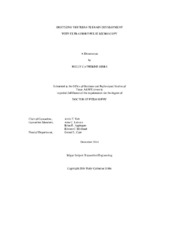| dc.description.abstract | Embryonic development is a process of unparalleled dynamism. The only constant in development is change itself- change in size, change in shape, change in gene expression- all driving the formation of an organism from a single cell. While the complexity of these changes is fascinating, it creates quite a challenge for modern imaging systems aimed at visualizing developmental processes.
The embryonic brain is subdivided by unique patterns of gene expression prior to morphogenesis, but the mechanisms linking these phenomena remain poorly understood in part due to the lack of imaging techniques that can capture dynamic molecular, cellular, and tissue-scale dynamics simultaneously in 3-D.
We have established the use of Ultrashort Pulse Microscopy, a platform that utilizes the high peak power and short coherence length of broadband ultrashort pulses to simultaneously generate two-photon excited fluorescence and high-resolution optical coherence signals, and 3-D image registration for integrated imaging and analysis of morphogenesis, genetic cell lineage reporter dynamics, and gene expression domains during embryonic brain patterning in the vertebrate model Danio rerio (zebrafish).
Using these tools, we characterized wnt1 lineage dynamics during midbrain-hindbrain boundary (MHB) formation and found differences in the refinement of gene expression domains along the dorsoventral axis at the boundary where wnt1 and fgf8a form an interface. We then examined these dynamics in fgf8a loss of function and showed that initiation of the morphogenetic program at the boundary does not require fgf8a, but that anteriorly expanded hindbrain ventricle opening and failure to restrict the posterior limit of wnt1 expression at the dorsal MHB results in a cerebellar to tectal transformation and termination of constriction morphogenesis. | en |


